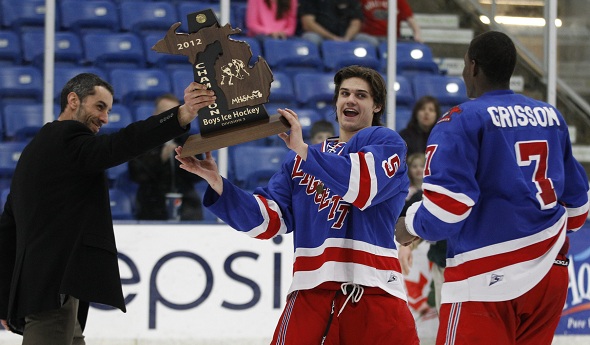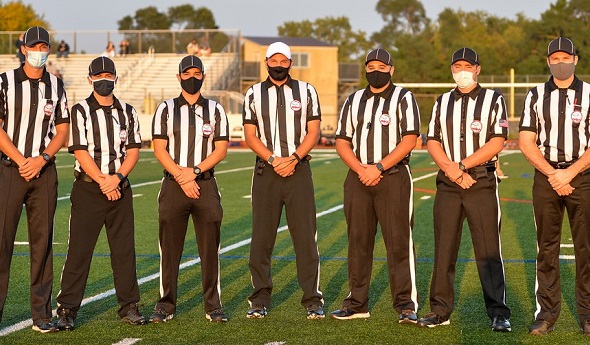
A Narrower Scope to Target New Officials
October 12, 2012
By Rob Kaminski
MHSAA benchmarks editor
Several years ago, MHSAA schools received thousands of postcards imploring graduating student-athletes to “Stay in the Game” by registering as contest officials.
A miniscule portion of that quantity found its way back to 1661 Ramblewood Drive. It’s a better bet you are reading this issue of benchmarks on the rest, in the form of recycled paper.
The plan for 2012-13, then, was to move away from the mass marketing approach and narrow the scope with the help of school administrators. Each MHSAA member school athletic director was sent a memo last May, along with two registration invitations. The memo simply asked the ADs to identify two officiating candidates from the senior class and deliver the special registration form. Completed forms were returned to the MHSAA, which not only waived all sign-up fees for the student’s first year, but also set the rookies up with local associations and training opportunities.
“We took this approach as a more measured strategy knowing that officiating is not for everyone,” said MHSAA Assistant Director Mark Uyl. “Instead of marketing to everyone, we hoped that ADs would give serious time and thought in selecting two graduating seniors who seemed best equipped in terms of personality and comportment for officiating.”
 Uyl set a modest goal of attracting 50 new officials through this program, and the Association is nearly halfway there at this printing, as 22 young men and women will make their first calls during the 2012-13 season.
Uyl set a modest goal of attracting 50 new officials through this program, and the Association is nearly halfway there at this printing, as 22 young men and women will make their first calls during the 2012-13 season.
Or, at least their first calls at the high school level. One of the “rookies” is Jake Hodges, who co-captained Grosse Pointe Woods University Liggett to the 2012 MHSAA Division 3 Ice Hockey title.
“I have been a USA Hockey ref for six years, and I plan to continue in college. It is good income,” said Hodges, who also plans to work lacrosse. “I had planned to register anyway so the free registration was great. I expect to work often and continue to be a solid ref. I also played lacrosse for four years and think that will allow for a good transition.”
The process has culled candidates from Michigan’s cities, suburbs and rural areas, from below and above the Mackinac Bridge.
“I have always been interested in officiating. The biggest incentive was the free registration,” said Negaunee’s Kevin Price, who registered in baseball, softball and basketball. “I hope this year will be a learning experience as I work games with long-time officials. As a player, I got to know many officials and we have become friends. The local officials in my area have done a great job giving me advice on my upcoming ‘rookie’ season.”
Many students registered for more than one sport, with a high of seven sports for Montrel Hill of Melvindale.
Early returns give Uyl and the MHSAA reason for optimism.
“We will continue this incentive plan again next year as we try to grow the pool of new, young officials,” Uyl said.
PHOTO: Jake Hodges (center) hoists the MHSAA Division 3 championship trophy after his Grosse Pointe Woods University Liggett team claimed the title in March.
NOTE: This is the third installment in the series "Making – and Answering – the Call" detailing the careers and service of MHSAA officials. Click the links below to view the two.

The Official View: The Next Generation
By
Brent Rice
MHSAA Assistant Director
October 27, 2020
By Brent Rice
MHSAA Assistant Director
At a time when we continually hear about the aging population of our veteran officials, it is refreshing to have an entire varsity crew made up of officials under 30.
 The MHSAA continues to push to recruit the next generation of officials. Current officials can do their part by signing up someone new each year … and of any age.
The MHSAA continues to push to recruit the next generation of officials. Current officials can do their part by signing up someone new each year … and of any age.
We kick of our October installment of “The Official View” with this photo of one of those up-and-coming crews.
Pictured above (left to right) are Nick Wallace, Joey Lapinski, Dan Dobrosielski, Nick Meyer, Zach Ferguson, Austin White and Kevin Klein.
It’s Official!
Postseason assignments: Officials in cross country, football, soccer, swim and volleyball are being notified of their postseason assignments. Especially during a year when it has been difficult to find officials to conduct our sports safely and fairly, we appreciate all of those who have been able to put on the uniforms for both the regular and postseason. For those who were not able to officiate this year, we understand; and we look forward to having you back as soon as we can get back to normal.
Meetings & exams: Rules meetings for winter sports have been released, and tournament exams will soon follow. Please make sure to mark Dec. 10 on your calendar as the date when winter postseason eligibility requirements are due for officials.
Guidelines: Officials for all sports can keep up-to-date on facial covering requirements by CLICKING HERE, and stay current on policies for your specific sport by going to the sport-specific officials page of the MHSAA website.
Know Your Rules
SWIMMING For an event requiring a forward start, a swimmer requests permission to start in the water.
Ruling: This is permissible. In order to remain legal though, the swimmer must enter the pool feet first.
It’s Your Call
Last month’s IYC involved a trick play with Team A players leaving the playing field. First this is a no goal, and each of the players that left without the permission of the official should receive a yellow card. However, since the cards occurred during a stoppage of play, and before the kick was made, Team A retains the corner kick when play resumes.
VOLLEYBALL The newest “It’s Your Call” comes from the volleyball court. Team A’s kill attempt is blocked back to its side of the net. As the ball is about to hit the floor, A13 lunges her leg out and kicks the ball in the air. Then, the libero instinctively kicks her leg out, doing the same. Finally, A3 makes a diving dig back to the other side of the net. The ball lands in, near Team B’s end line. What’s the call?
The Official View: What’s in a Uniform
Officials in most sports are identified by the style of their shirts. Soccer referees are well-known for wearing shirts in a variety of bright, stunning colors. For many years, baseball umpires were so closely identified with the color of their uniform tops, they were (and often still are) contemptibly referred to as “Blue.”
But perhaps there is no more iconic uniform shirt than the black and white stripes worn by officials in a number of sports over the last century. In fact, this easily recognizable pattern associated with referees has its origins in Michigan high school sports.
That’s right, the first reported occurrence of any official wearing stripes goes back to the 1921 Michigan high school basketball finals. That referee was Lloyd Olds, and he was a multi-sport official out of Ypsilanti. The idea came to him following an unfortunate incident in a college football game when the Arizona quarterback mistook Olds as a teammate and threw him the football. You see, the Arizona team wore white uniforms, and were very similar looking to Olds’ own officials uniform – consisting of black slacks and a white dress shirt with bow tie. It became apparent to him that officials should wear a uniform that distinguished them from the teams.
When Olds returned home, he sat down with friend and sporting goods store owner, Greg Moe, to design the first black-and-white striped uniform. He decided to pull the uniform shirt out of the closet for the final game of the high school basketball postseason, and soon began wearing it when he worked both basketball and football.
This new outfit quickly caught on at both the high school and college levels, and it wasn’t long before this became the norm around the world and across all levels. While officials’ uniforms regularly change these days, some form of stripes will likely be around forever – and it all started with a Michigan high school official.
If you have an interesting story or an official you’d like to see promoted, send details and pictures to [email protected].

